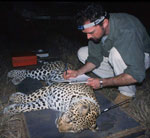First park established in Russian Far East
First park established in Russian Far East
mongabay.com
June 8, 2007
Russia has established the first national park in the far eastern part of the country. The initiative seeks to protect endangered Amur tigers from extinction due to poaching and habitat loss.
According to WWF, an environmental group that has worked for years to establish the park, The Zov Tigra (Call of the Tiger) National Park encompasses 82,152 hectares of forest area in the Sikhote-Alin mountain range in the far eastern Primorye region.
“The main purpose of the national park is to conserve biodiversity and develop eco-tourism in the region,” said Yurii Bersenev, protected areas coordinator for WWF-Russia’s Far Eastern office.
“Thanks to the positive cooperation between WWF and the Russian authorities, we were successful in establishing the park. We are happy to see this unique natural area finally getting the protection it deserves.”
The Russian Far East is home to around 500 Amur, also called Siberian, Tigers.
Russia plans to add 21 protected areas by 2010 according to WWF. Zov Tigra is the third to date.
Related articles
Tiger parts trade must be banned to save great cats
(6/5/2007) Trade in tiger products must be banned if tigers are to survive in the wild, reports a study published in Bioscience. The paper, The Fate of Wild Tigers, characterizes the decline in wild tiger population as 'catastrophic' and urges governments to outlaw all trade in tiger products from wild and captive-bred sources as well as step up conservation efforts.
 |
Saving big cats depends on science, practical interventions
(5/21/2007) Big cats are some of Earth's largest and most threatened predators. Long persecuted as perceived threats to livestock and humans, hunted for their skins and purported medicinal values, and losing critical habitat to deforestation and conversion for agriculture, big cat populations have dwindled around the world for the past century. Given these trends, it should come as no surprise that big cats have become the focus of conservation efforts. Not only are large predators often the most vulnerable to human pressures and the first to disappear from ecosystems, but efforts to conserve them effectively help protect thousands of other species that share their habitat. At the forefront of these efforts in Dr. Luke Hunter, a biologist with the Wildlife Conservation Society (WCS) where he heads their Great Cats Program. In a May 2007 interview with mongabay.com, Hunter discussed strategies for conserving carnivores and offered insight for students interested in pursuing careers in conservation science.
Tigers can recover given protection, adequate food supplies
(12/13/2006) A new study says that if tigers are protected and have sufficient access to abundant prey, their populations can quickly stabilize. The findings have implications for conservation of the world's largest cat species which is fast-disappearing due to poaching for the animal parts trade.
Tiger fur trade thrives in China
(9/28/2006) The illegal tiger and leopard fur trade continues to thrive in China according to recent investigations by the Environmental Investigation Agency (EIA) and the Wildlife Protection Society of India (WPSI). The organizations say that the trade is "operating without any hindrance from the Chinese government" and endangers surviving wild tiger populations in India
Tiger habitat declining
(7/20/2006) The most comprehensive scientific study of tiger habitats ever done finds that the big cats reside in 40 percent less habitat than they were thought to a decade ago. The tigers now occupy only 7 percent of their historic range.














